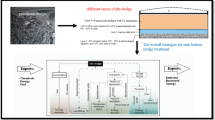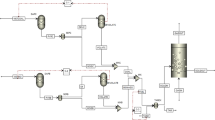Abstract
This paper presents a study on the effect of hydrothermal treatment (HTT) on municipal solid waste (MSW) and mechanical property of fuel pellet. The lab-scale HTT was conducted at the condition of 180–240 °C and 30–90 min. Results showed that the HTT could improve fuel property of MSW including heating value, dewatering and drying performance. The fuel pellet was produced at three different diameters (4, 6, and 8 mm). Tests of mechanical property and water adsorption were performed. Results showed that the fuel pellet was able to withstand the axial load of 19–54 N and the radial load of 72–130 N. The 8-mm pellet exhibited lowest Young’s modulus (18.26 MPa) indicating flexibility and ductility. Durability of the fuel pellet was high (91–94%) while the Hardgrove Grindability Index (HGI) was (57–76) higher than that of the biomass pellet (18–22) and the subbituminous coal (46–49) indicating the ease of grinding. The equilibrium moisture content of the fuel pellet was 5–6%. The small fuel pellet reached adsorption equilibrium faster than the large one. In sum, the fuel pellet produced from HTT showed good fuel property as well as mechanical property for transportation and utilization.







Similar content being viewed by others
References
Zhuang Y, Wu SW, Wang YL, Wu WX, Chen YX (2008) Source separation of household waste: a case study in. China Waste Manag 28:2022–2030. https://doi.org/10.1016/j.wasman.2007.08.012
Aphale O, Thyberg KL, Tonjes DJ (2015) Differences in waste generation, waste composition, and source separation across three waste districts in a New York suburb. Resour Conserv Recy 99:19–28
Areeprasert C, Kaharn J, Inseemeesak B, Phasee P, Khaobang C, Kuhavichanun A et al (2018) A comparative study on characteristic of locally source-separated and mixed MSW in Bangkok with possibility of material recycling. J Mater Cycles Waste 20:302–313
Caputo AC, Pelagagge PM (2002) RDF production plants: I design and costs. Appl Therm Eng 22:423–437
Visvanathan C, Trankler J. Municipal solid waste management in Asia: a comparative analysis. In: Workshop on sustainable landfill management, 2003, pp 3–5
Shekdar AV (2009) Sustainable solid waste management: an integrated approach for Asian countries. Waste Manag 29:1438–1448. https://doi.org/10.1016/j.wasman.2008.08.025
Cheng H, Hu Y (2010) Municipal solid waste (MSW) as a renewable source of energy: current and future practices in China. Bioresour Technol 101:3816–3824. https://doi.org/10.1016/j.biortech.2010.01.040
Zaman AU (2013) Identification of waste management development drivers and potential emerging waste treatment technologies International. J Environ Sci Technol (IJEST) 10:455
McKay G (2002) Dioxin characterisation, formation and minimisation during municipal solid waste (MSW) incineration. Chem Eng J 86:343–368
Manser AG, Keeling A (1996) Practical handbook of processing and recycling municipal waste. CRC Press, Boca Roton, Florida, USA
Sommerlad RE, Seeker WR, Finkelstein A, Kilgroe JD. Environmental characterization of refuse-derived-fuel incinerator technology. In: National Waste Processing Conference, Philadelphia, 1988
Kruse A, Dinjus E (2007) Hot compressed water as reaction medium and reactant. J Supercrit Fluids 39:362–380. https://doi.org/10.1016/j.supflu.2006.03.016
Mumme J, Eckervogt L, Pielert J, Diakite M, Rupp F, Kern J (2011) Hydrothermal carbonization of anaerobically digested maize silage. Bioresour Technol 102:9255–9260. https://doi.org/10.1016/j.biortech.2011.06.099
He C, Giannis A, Wang J-Y (2013) Conversion of sewage sludge to clean solid fuel using hydrothermal carbonization: Hydrochar fuel characteristics and combustion behavior. Appl Energy 111:257–266. https://doi.org/10.1016/j.apenergy.2013.04.084
Park S-J, Bae J-S, Lee D-W, Ra HW, Hong J-C, Choi Y-C (2011) Effects of hydrothermally pretreated sewage sludge on the stability and dispersibility of slurry fuel using pulverized. Coal Energ Fuel 25:3934–3939. https://doi.org/10.1021/ef200893p
Sevilla M, Fuertes AB (2009) The production of carbon materials by hydrothermal carbonization. of cellulose Carbon 47:2281–2289. https://doi.org/10.1016/j.carbon.2009.04.026
Parshetti GK, Liu Z, Jain A, Srinivasan MP, Balasubramanian R (2013) Hydrothermal carbonization of sewage sludge for energy production with coal. Fuel 111:201–210. https://doi.org/10.1016/j.fuel.2013.04.052
Berge ND, Ro KS, Mao J, Flora JR, Chappell MA, Bae S (2011) Hydrothermal carbonization of municipal waste streams. Environ Sci Technol 45:5696–5703. https://doi.org/10.1021/es2004528
Wiedner K, Rumpel C, Steiner C, Pozzi A, Maas R, Glaser B (2013) Chemical evaluation of chars produced by thermochemical conversion (gasification, pyrolysis and hydrothermal carbonization) of agro-industrial biomass on a commercial scale. Biomass Bioenerg 59:264–278. https://doi.org/10.1016/j.biombioe.2013.08.026
Oliveira I, Blohse D, Ramke HG (2013) Hydrothermal carbonization of agricultural residues. Bioresour Technol 142:138–146. https://doi.org/10.1016/j.biortech.2013.04.125
Namioka T, Morohashi Y, Yamane R, Yoshikawa K (2009) Hydrothermal treatment of dewatered sewage sludge cake for solid fuel production. J Environ Eng 4:68–77. https://doi.org/10.1299/jee.4.68
Prawisudha P, Namioka T, Yoshikawa K (2012) Coal alternative fuel production from municipal solid wastes employing hydrothermal treatment. Appl Energy 90:298–304. https://doi.org/10.1016/j.apenergy.2011.03.021
Muthuraman M, Namioka T, Yoshikawa K (2010) A comparative study on co-combustion performance of municipal solid waste and Indonesian coal with high ash Indian coal: a thermogravimetric analysis. Fuel Process Technol 91:550–558. https://doi.org/10.1016/j.fuproc.2009.12.018
Nakhshiniev B, Gonzales HB, Yoshikawa K (2012) Hydrothermal treatment of date palm lignocellulose residue for organic fertilizer conversion: effect on cell wall and aerobic degradation rate. Compost Sci Util 20:245–253
Ma D, Zhang G, Zhao P, Areeprasert C, Shen Y, Yoshikawa K et al (2015) Hydrothermal treatment of antibiotic mycelial dreg: more understanding from fuel characteristics. Chem Eng J. https://doi.org/10.1016/j.cej.2015.01.041
Areeprasert C, Zhao P, Ma D, Shen Y, Yoshikawa K (2014) Alternative solid fuel production from paper sludge employing hydrothermal. Treatment Energ Fuel 28:1198–1206. https://doi.org/10.1021/ef402371h
Ma D, Zhang G, Areeprasert C, Li C, Shen Y, Yoshikawa K et al (2016) Characterization of NO emission in combustion of hydrothermally treated antibiotic mycelial residue. Chem Eng J 284:708–715
Areeprasert C, Scala F, Coppola A, Urciuolo M, Chirone R, Chanyavanich P et al (2016) Fluidized bed co-combustion of hydrothermally treated paper sludge with two coals of different rank. Fuel Process Technol 144:230–238
Kaliyan N, Vance Morey R (2009) Factors affecting strength and durability of densified biomass products. Biomass Bioenerg 33:337–359. https://doi.org/10.1016/j.biombioe.2008.08.005
Krogh S (1980) Crushing characteristics. Powder Technol 27:171–181
Lam PS, Sokhansanj S, Bi X, Lim CJ, Melin S (2011) Energy input and quality of pellets made from steam-exploded Douglas fir (Pseudotsuga menziesii). Energ Fuel 25:1521–1528. https://doi.org/10.1021/ef101683s
Li H, Liu X, Legros R, Bi XT, Jim Lim C, Sokhansanj S (2012) Pelletization of torrefied sawdust and properties of torrefied pellets. Appl Energy 93:680–685. https://doi.org/10.1016/j.apenergy.2012.01.002
Zaini IN, Novianti S, Nurdiawati A, Irhamna AR, Aziz M, Yoshikawa K (2017) Investigation of the physical characteristics of washed hydrochar pellets made from empty fruit bunch. Fuel Process Technol 160:109–120
Stelte W, Nielsen NPK, Hansen HO, Dahl J, Shang L, Sanadi AR (2013) Reprint of: Pelletizing properties of torrefied wheat straw. Biomass Bioenerg 53:105–112
Stelte W, Clemons C, Holm JK, Sanadi AR, Ahrenfeldt J, Shang L et al (2011) Pelletizing properties of torrefied spruce. Biomass Bioenerg 35:4690–4698
Peng J, Bi X, Sokhansanj S, Lim C (2013) Torrefaction and densification of different species of softwood residues. Fuel 111:411–421
Areeprasert C, Kaewmorakot S, Suwanwattana W, Rungrueangwattanachot N, Klahan J, Siripaiboon C et al. (2016) Fertilizer pellet production from filter cake and water as a binder employing a flat-die pelletizer. Thai Soc Agric Eng J 22:1–6
ASABE C (2001) Pellets and crumbles–definitions and methods for determining density, durability and moisture content American Society of Agricultural Engineers. The American Society of Agricultural Engineers, St Joseph, pp 537–539
Zhou H, Long Y, Meng A, Li Q, Zhang Y (2015) Thermogravimetric characteristics of typical municipal solid waste fractions during co-pyrolysis. Waste Manag 38:194–200
Chattopadhyay J, Kim C, Kim R, Pak D (2008) Thermogravimetric characteristics and kinetic study of biomass co-pyrolysis with plastics. Korean J Chem Eng 25:1047–1053
Saidur R, Abdelaziz EA, Demirbas A, Hossain MS, Mekhilef S (2011) A review on biomass as a fuel for boilers. Renew Sust Energ Rev 15:2262–2289. https://doi.org/10.1016/j.rser.2011.02.015
European Pellet Council (2015) ENplus handbook part 3 pellet quality requirements, vol. 3, European Biomass Association, Brussels, Belgium
Kambo HS, Dutta A (2014) Strength, storage, and combustion characteristics of densified lignocellulosic biomass produced via torrefaction and hydrothermal carbonization. Appl Energy 135:182–191
Hower J (1990) Hardgrove grindability index and petrology used as an enhanced predictor of coal feed rate. Energeia (Lexington, Kentucky) (USA) 1–6
Acknowledgements
This research has received funding from the Thailand Research Fund (MRG5980058). Authors would like to thank Dr. Kunio Yoshikawa and Dr. Wichai Siwakosit for essential advice and Dr. Bayu Indrawan, Center of Waste Management of Indonesia, for substantial support.
Author information
Authors and Affiliations
Corresponding author
Rights and permissions
About this article
Cite this article
Phasee, P., Areeprasert, C. An investigation on mechanical property of MSW-derived fuel pellet produced from hydrothermal treatment. J Mater Cycles Waste Manag 20, 2028–2040 (2018). https://doi.org/10.1007/s10163-018-0752-3
Received:
Accepted:
Published:
Issue Date:
DOI: https://doi.org/10.1007/s10163-018-0752-3




